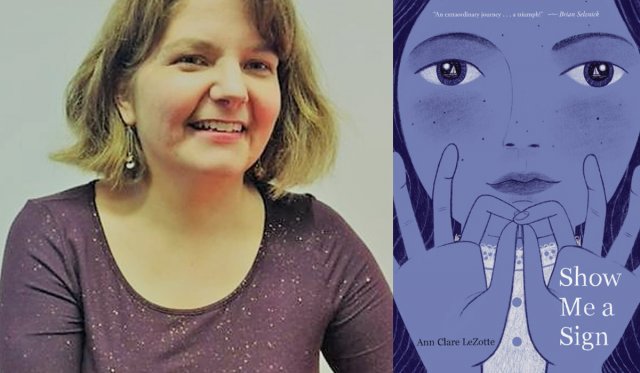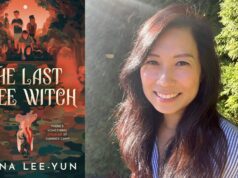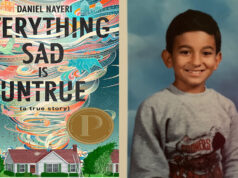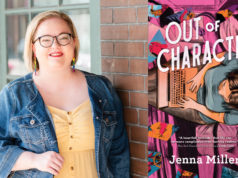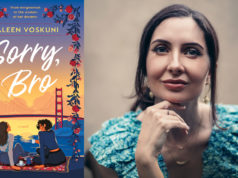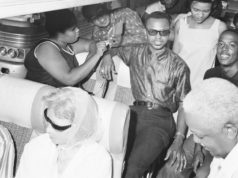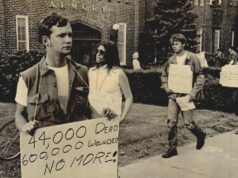
(Editor’s note: NonDoc’s Author Umbrella interviews up-and-coming writers, particularly authors of color, authors of disability and LGBTQ+ authors. The interviews have been transcribed and lightly edited for length and clarity.)
For this latest installment of Author Umbrella, I interviewed Ann Clare LeZotte, author of Show Me a Sign. The highly acclaimed novel, published by Scholastic, hit shelves March 3.
A quick preview:
Mary Lambert has always felt safe and protected on her beloved island of Martha’s Vineyard. Her great-grandfather was an early English settler and the first deaf islander. Now, over a hundred years later, many people there — including Mary — are deaf, and nearly everyone can communicate in sign language. Mary has never felt isolated. She is proud of her lineage.
But recent events have delivered winds of change. Mary’s brother died, leaving her family shattered. Tensions over land disputes are mounting between English settlers and the Wampanoag people. And a cunning young scientist has arrived, hoping to discover the origin of the island’s prevalent deafness. His maniacal drive to find answers soon renders Mary a “live specimen” in a cruel experiment. Her struggle to save herself is at the core of this novel.
1) As a retired librarian, what is it like to see your own book on a bookshelf in bookstores and in libraries?
With #ShowMeASign deaf author and librarian @annclezotte weaves a riveting #ownvoices story inspired by the true history of a thriving deaf community on Martha’s Vineyard in the early 19th century. Start reading: https://t.co/Z0V0j4099H pic.twitter.com/Qm3fEwoHik
— Scholastic (@Scholastic) April 24, 2020
I have yet to see Show Me a Sign in a bookstore (because of the COVID-19 pandemic), but I was delighted to trap it for a hold at the library, with the plastic book cover and “local author” sticker on the spine!
2) I’m hard of hearing, and although I don’t know American Sign Language, I’ve been told that its structure is quite different from spoken/written English. What challenges did you face in translating the deaf experience into written English?
Nice to meet, HoH fam! The truth is, I’ve struggled with English literacy since I was a kid. There’s home sign, ASL, and a riot of emotion inside me that I can’t always get down on the page. When it all starts to flow together, it’s nearly miraculous!
Show Me a Sign begins in a deaf-inclusive, signing town. That Mary and several other characters think and communicate like me helped me to find my bearings. Still, my editor’s guidance was essential. With her expertise, she assisted me in putting the disparate pieces together. Having her understanding that I was taking a different path than her other clients made it work; and my determination that I could write a novel for children. There were rough patches, I can tell you.
3) Show Me a Sign has been lauded for deftly exploring the multicultural community of the Wampanoag island called Noepe. What steps did you take to write about the Wampanoag without perpetuating stereotypes?
I’m sure I included stereotypes. But when I realized that I couldn’t just write about a white deaf utopia because Mary and her friends and family are colonizers on Native land, I did all the research I could. I made a point of seeking out Wampanoag resources. But reading books isn’t enough. I connected with local Afro-Indigenous families I knew through the library.
A Black Cherokee librarian friend introduced me to a cultural sensitivity reader. Penny Gamble-Williams is a Black Chappaquiddick spiritual leader who is also hard of hearing. She’s thorough and generous. It’s a question of “listening” to first-hand sources and being willing to do the work with care and change your assumptions when challenged.
4) I loved the “book bandit” video from your Twitter feed. What books do you love to share with your young resistant readers?
Book bandit! Coworker J. Eang grabs my 1st hardcover copy of SHOW ME A SIGN. Don’t try this @ your library! 😂📚🤟 @Scholastic #saturdaylibrarian #ASL #Deaf pic.twitter.com/Tt6LWQAi19
— Ann Clare LeZotte (@annclezotte) February 1, 2020
I’ll tell my former colleague, Jeremiah Eang, who was in the video. He did two tours as an Army medic in Afghanistan before joining the library — and he can run!
Especially with reluctant and delayed readers, it’s important to find out what young readers are interested in so you don’t turn them off books completely. That may be Dog Man or a Pokémon handbook, which is fine, but you try to slip something else in there, too.
A couple of not-too-intimidating 2020 releases of excellent quality that I recommend are Lauren Castillo’s Our Friend Hedgehog: The Story of Us and Torey Maldonado’s What Lane? Erin Entrada Kelly’s Hello, Universe is always a standby and includes a deaf character. Christine Day’s I Can Make This Promise is terrific — she’s a talent to watch!
5) What do you hope young readers will take away from Show Me a Sign?
I want deaf readers to see someone like them. I’ve received some amazing feedback: “It’s the first time I’m seeing someone like me!”
I want all young readers to consider which is the problem: that Mary is deaf, or how the larger world views and treats her because of her deafness? It’s really a book about ableism, though I don’t use contemporary, abstract concepts like that.
Perhaps it will encourage them not to see disabilities as deficiencies. Deaf community exists. We have our own language, history and culture. But it’s not something apart from them, as anyone can learn ASL and have deaf friends who aren’t that different from them.
6) Show Me a Sign was released just as COVID-19 was shuttering many events and stores across the country. The year 2020 being what it is, did that affect how you promoted your work? If so, how?
It affected everything. All conferences and book signings were cancelled. Many events went online. Some of these were accessible to me as an author, while many were not. I became ill and was hospitalized. My health is weakened to the degree that I retired early from the library.
But it’s been a blessed year, too. The book was released on March 3, and here we are in December talking about it. I’m grateful for the continuing interest and enthusiasm, and I’ve spent my time in bed writing a companion book to be released next year.
7) What do you think would most appeal to Oklahoma readers about Show Me a Sign?
I hate to quote a starred review, but Kirkus Review said the book was “an all-too-rare thing: an excellent book about a deaf person.” I hope it becomes less rare, but it engenders understanding. And when I Googled, I saw that Oklahoma has a vibrant deaf community too.
Thanks, and KISSFIST (as we say in ASL)!









